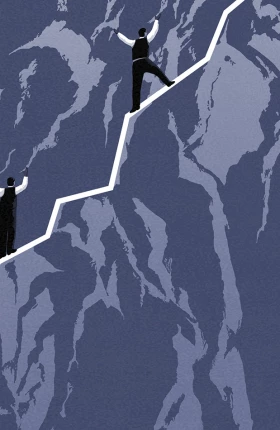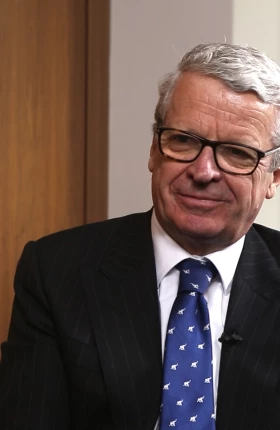Nils Andersen, the CEO of the Maersk Group, is by many accounts the most accomplished transformation leader in northern Europe. He took over his first CEO job at 32, launching a turnaround effort at a Spanish brewery that was majority-owned by Carlsberg Group. He later ran Carlsberg, starting in 2001, where he oversaw a far larger effort to improve operational efficiency and grow through acquisitions. By the time he left the company in 2007, Carlsberg was the fourth-largest beer company in the world, and the transformation had created tremendous value.
At the Maersk Group, where he became CEO in 2007, Andersen was tasked with modernizing a diversified business with a strong heritage and more than $50 billion in annual revenue. The shipping and oil giant, founded in 1904 and based in Copenhagen, had a wide range of divisions, which Andersen restructured into four core business units with clear performance objectives and greater accountability. The transformation succeeded—Maersk Group now has industry-leading profitability, generates a double-digit return on capital invested, and has fared remarkably well in the difficult shipping and oil segments.
Andersen recently sat down with Lars Fæste, a senior partner at BCG and head of the firm’s transformation practice, to share his thoughts on leadership through transformation. Edited excerpts from that conversation follow.
About Nils S. Andersen
At a Glance
Born in Aarhus, Denmark
Year Born: 1958
Education
Master of Economics, Aarhus
Career Highlights
2007–present, Group CEO, A.P. Moller-Maersk
2001–2007, CEO, Carlsberg
Outside Activities
Member of the Board, Inditex
Member of the Board, Unilever
Chairman of the Board, Dansk Supermarked
Can you talk about the transformation effort at Carlsberg?
Carlsberg’s underlying earnings were very weak when I took over, and we lacked scale to compete on a global level. So the company was in danger of being marginalized as a very small regional brewery. Before we could implement a transformation, we had to align a lot of businesses that Carlsberg had acquired but where other companies held an ownership stake. Those were often managed as independent businesses. So we had to create operating control of the businesses and align managers.
With those businesses aligned, we did a complete turnaround in terms of operational effectiveness, which included everything from production, distribution, commercial to how much overhead we could afford in management. We reduced costs, focused our portfolio of brands, and improved advertising efficiency. As a result of those efforts, we were able to execute a number of acquisitions to build up the necessary scale and then finally a merger with Orkla, a Norwegian conglomerate. I think that deal was the real turning point—it made us a clear market leader in the Nordic area and gave us 50 percent ownership of the largest Russian player. During the five-year period where I was CEO of Carlsberg, the share price increased several-fold, so it was a good learning experience.
How does that compare to the transformation effort you launched at the Maersk Group?
Contrary to Carlsberg, here the situation was different because the operational knowledge and expertise of the organization was very high in most areas. So the most important thing was to become less bureaucratic and internally focused, and instead create an organization that focused on the markets and being competitive. To achieve that, we restructured the company. Instead of a group of companies with subgroupings, we created five independent business units. Even if those units supplied services to each other, we introduced the “arm’s-length principle,” which we still pursue with religious vigor. We also made sure that everybody knew exactly what they were accountable for, and we measured, rewarded, promoted, and took negative consequences based on how the businesses were performing in their own right.
We also focused the portfolio of businesses, again by making sure everybody knew what the objectives were and creating a clear strategy. We defined four core businesses and said these are the areas that we want to grow and that will require a lot of capital. Therefore, when we sell smaller businesses that are no longer core, it is not a loss or a negative development. It’s necessary because otherwise we cannot finance the growth. In a conglomerate where the number of businesses has been a source of pride, of course there are always some feelings involved, when we divest, even smaller businesses. But I think we got people aligned around the overall reasoning behind it.
What results have you seen on the transformation thus far?
I think it is fair to say that we delivered very well on the profitability figures, particularly considering the industry is going through a lot of change. Underlying profitability is strong.
In terms of ROI, we’ve managed to get a good payback in monetary terms from the activities we took on. Over the period of the transformation, we’ve seen a double-digit return on capital employed. And so we’ve almost doubled the equity by investing quite a bit of money in growing the four core businesses.
The business you’re in is characterized by a lot of volatility. With so many changes taking place in the market, how do you think about managing “business as usual” versus making transformative moves?
We are in a very volatile business, that’s true. But you still need to have a longer-term vision of what customers will require of us in 5, 10, or 20 years. If you take that perspective, you can adapt through tactical moves, but the business is able to stay on course during up-and-down periods.
To a certain extent, we have secured that through the restructuring, by selling noncore businesses and increasing earnings. We now have quite a strong balance sheet and relatively low leverage in the business, so we have the luxury of being able to hold steady during short-term volatility. Having said that, short-term volatility can be the beginning of longer and more fundamental changes, which is why you have to have an eye out all the time to understand the real underlying trends. We spend a lot of time and resources in understanding the global economy and market trends in our industries.
I would imagine that pace of change is another difference compared with your time at Carlsberg.
Carlsberg was very different, because you have a completely different level of stability when you have consumer brands and production and distribution systems underlying your business. In the shipping business, the life of an asset is 30 years, and a lot is dictated by markets and trends that you can’t change in the short term. In the fast-moving consumer goods business, you’re more short term and “on the ball" in responding to trends, but longer-term volatility is much lower. That has an impact on many things, including how much you can leverage the business and what your planning horizon should be.
So you can say that shipping is more volatile on a strategic level. And FMCG is more volatile on a technical and tactical, where you’re making operational decisions every day to make sure you do the right promotions and are in the right stores and so on.
In implementing these transformation efforts, what techniques have you used to bring the management team along?
First of all, it’s a matter of how you lead. I am very transparent. I spend a lot of time with the teams making sure that we are aligned on strategy. And then I’m basically there whenever I’m needed, but I’m not meddling in day-to-day business, at least not in my present job.
Another factor is that when you’re running a conglomerate, you have to make sure that all your top managers understand the broader objectives of the conglomerate. Maybe they don’t need that to run their day-to-day business, but they have to understand the criteria for allocating capital and whether it is fine to grow or hold or whatever in the strategy you implement for the business. If they don’t understand this, their motivation suffers.
The third element—and I think the most important one—is that you want to make sure everyone pushes each other and searches for new ways to do things. For example, we do a lot in terms of maintaining contact with the academic environment. We once took 150 people to Harvard to spend a week together to learn and discuss the businesses, and this year we were at Stanford with 30 people to see how we could benefit from new technology and new developments. So I try to make sure that people are inspired and draw on external ideas. The biggest worry I have is that people get happy with themselves and complacent. There’s a real risk of focusing inwards, where people forget the markets and think they can live in their own framework.
Given that the group is performing very well right now, how do you keep this complacency out and continually push people to do more?
I think you have to keep raising the bar. All of our managers understand that we are in a volatile business, so we all fear the next downturn and know that it’s coming at some point. We try to stay hungry. All of the businesses have plans in place, and we go through those very carefully. The goal is to help make sure they reach their potential by identifying what the next step might be, but also looking ahead to what the next danger could be. We spend a lot of time on that.
Given all the times you have taken office as a The New CEO’s Guide to Transformation and immediately sought to introduce change, what advice would you give to a The New CEO’s Guide to Transformation ?
It depends on the situation and on what kind of job it is, but in general I think it’s really worthwhile to listen to as many employees and managers of the business as possible. Normally 90 percent of the ideas and solutions are already available in the organization, often as unimplemented blueprints or as vague ideas that have been lost in translation. An outside-in view of the company is important too, which new CEOs can get by talking to customers and authorities to see how they view the company and what it’s strengths and weaknesses are. In general, it’s really important to make sure that you listen and try to understand the company’s situation. You can’t develop that kind of understanding on your own.





